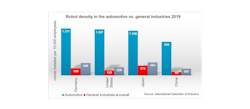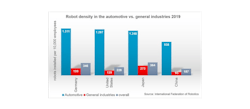US robot density ranks 7th in car industry
The robot density in the US automotive industry hit a record of 1,287 installed units per 10,000 employees according to the latest World Robotics statistics issued by the International Federation of Robotics (IFR). The United States ranks seventh worldwide. The density is similar to Germany at 1,311 units and Japan at 1,248 units. China is in twelfth place with 938 units.
(Source: IFR)
"Automation is the key not only to post-pandemic recovery, but to post-pandemic growth and progress,” said Milton Guerry, president of IFR. "In the upswing after the 2008 financial crisis, companies like General Motors, Ford, Fiat-Chrysler, and Tesla invested extensively in robotics and automation. As a result, thousands of new jobs were created within the automotive industry. So many years and technological advancements later, we have the opportunity to learn from this success story and emerge even stronger than before."
Robot density in the general industry is stands only at 139 units per 10,000 employees. In the U.S., yearly orders of robots from non-automotive sectors surpassed automotive robot orders for the first time. Sales of robotic units in the U.S. increased 7% in 2020 from 2019. Year-over-year orders in life sciences increased by 72%, food and consumer goods grew by 60%, and plastics and rubber saw a 62% increase.


